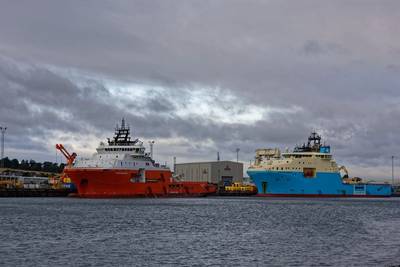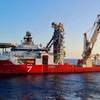$3 Billion Forecast to be Invested in New Anchor Handlers to Meet Floating Wind Demand
Floating wind is an emerging technology. Currently being tested in small scale demonstration and pilot projects, global floating wind commissioned capacity at the end of 2022 was less than 200 megawatts (MW). By 2030, close to 11 gigawatts (GW) of commercial scale wind farms are planned to be commissioned in Europe and the Asia Pacific Region. Then, 2030-2035 will see a period a high commissioning activity as the U.S. joins established European and Asia Pacific markets. Floating installed capacity is forecast to reach 63 GW by 2035. This translates to the installation of close to 4,000 floating turbines, over 16,000 anchors and close to 17,000 mooring lines. These are the findings of a new report and market forecast for floating wind farm installation vessel demand through 2035 prepared by Intelatus Global Partners.
In the report, Intelatus provides an overview of the industry and an assessment of the underlying market drivers likely to prevail through the 2035 forecast period. Then Intelatus presents our forecast for floating offshore wind turbine installation vessel demand. Next, Intelatus profiles the mooring pre-lay, towing and hook-up vessel supply side and analyze the supply and demand balances through the forecast period. Finally, Intelatus presents several case studies of existing floating wind projects.
Whereas floating wind projects will leverage experiences from the bottom-fixed industry, there will also be many differences, particularly in how floating turbines are constructed and installed. The differences drive demand for a different type of vessel than seen for bottom-fixed offshore wind projects.
For floating wind projects, we will see the largest anchor handlers and light subsea construction vessels deployed to pre-install mooring systems designed to maintain the position of the floating wind turbines, to tow the structures from port and to hook-up the floating turbines to pre-existing moorings. For example, the analysis identifies the optimal size of anchor handling tug supply (AHTS) vessels for mooring pre-lay as having a bollard pull of at least 250 tonnes and a clear back deck of over 800 square meters.
The large anchor handling segment has seen limited recent new building activity due to poor market conditions in the core oil and gas sector, with only five large anchor handlers delivered in the last five years. Oil and gas activity is currently picking up, reducing available supply. The challenge is accentuated by an aging fleet, much of which becomes technically uncompetitive by 2030. As a result, our forecast identifies a large anchor handler shortage of around 30 vessels after 2030. Newbuilding prices for large anchor handlers were around $80-85 million in 2015/16, when large anchor handlers were last contracted. Since then, there has been limited activity to guide price estimates. However, a capital cost estimate of at least $100 million per vessel seems reasonable, meaning that potentially $3 billion will be invested in new built optimal anchor handlers to meet floating wind demand.
For more information about the Intelatus Global Partners, visit www.intelatus.com or contact Philip Lewis at +44 203-966-2492.















